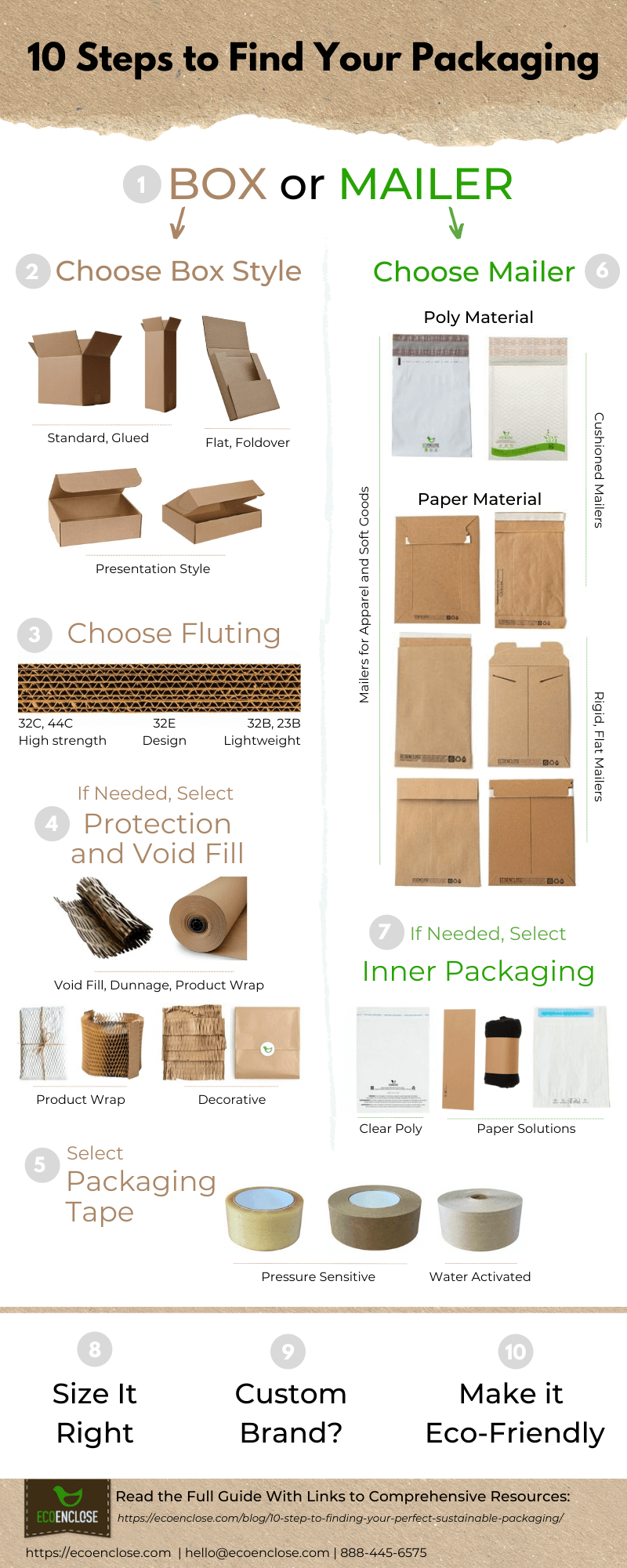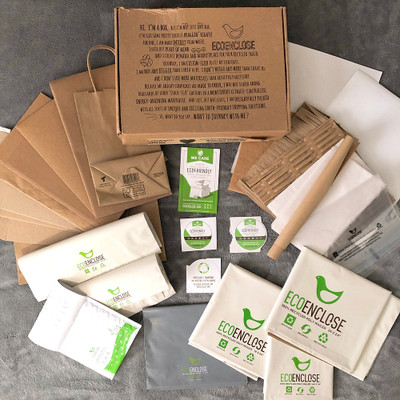10 Steps to Finding Your Perfect Sustainable Packaging
Posted on Jan 19th 2022
10 Step to Finding Your Perfect Sustainable Packaging
We know the search for the packaging to ship your online orders can be daunting. EcoEnclose offers dozens of different packaging solutions, each in many sizes. If you're not sure what kind of packaging is best for your products, it can be difficult to know where to start.
This blog post is for any individual or business that is just starting on the packaging journey or is taking time at the beginning of 2022 to redesign packaging to better meet brand, sustainability, and/or budget goals.
The following graphic visualizes the 10 different steps for businesses to consider.
Below the graphic, find some basic guidance on how to execute each decision point, and links to more detailed resources.

Decision 1: Choose between a box or a mailer
A mailer wins on almost every operational, cost and sustainability dimension - so if you can effectively use one for your products, we typically recommend it over a box. However, a shipping box typically offers a higher-end customer experience, a differential that can tip the balance in favor of boxes for some brands.
Read more: Choosing Between a Shipping Box and a Mailer.
Decision 2: If you're going with a box, choose your box style
Presentation style boxes (tab locking or literature mailer) deliver a premium, engaging experience. "Glued" boxes like RSCs are a bit more standard and are great for a variety of shipments. The OPF (one-panel fold) box is excellent for flat, thin shipments.
Read more: What Type of Shipping Box Should I Use?
Decision 3: Once you've chosen your box style, decide on your fluting
Tab Locking and Literature Mailers - for small to mid-sized boxes, opt for E flute where possible. This fluting leads to tight, sleek boxes that are sure to wow your customers. B flute is great if you are concerned at all about crushing or are using larger boxes.
RSC and FPF boxes - choose C flute! 32C works for most shipments, but if you are shipping over 30 lbs, go with 44C.
OPF - B flute works for most shipments, but heavier shipments or ones that need to avoid any crushing should use C flute.
Read more: What Are Flutes and What Corrugated Material Should I Use?
Decision 4: Determine if you need protective packaging and what type is best
Protective packaging serves different purposes:
Individual product protection (wrapping each product to protect them from breaking) - GreenWrap, Flexi-Hex, Corrugated Bubble, and Packaging Paper
Void fill (filing air in boxes to protect items from movement) - Packaging Paper and Corrugated Bubble
Cushioning and Edge Protection - Ornament Shred, Corrugated Pads, Corrugated Bubble and Packaging Paper
Scuff and Dust Protection, Decoration - Tissue Paper, Ornament Shred
Read more: Eco-Friendly Protective Packaging Options, Definitive Guide to Protective Packaging and Void Fill
Decision 5: Choose your packaging tape
Pressure- sensitive tape adheres to your boxes with pressure, while water-activated tape is wetted to bond to your boxes. Where possible, we recommend the water-activated tape as it is more effectively cost-efficient, eco-friendly. However, WAT generally requires the upfront investment in a manual or electric dispenser.
Read more: Find the Most Eco-Friendly Packaging Tape
Decision 6: If you're going with a mailer, choose your mailer type
For apparel and soft goods, choose between poly mailers, apparel mailers, Kraft mailers, and EcoX mailers. An important question many customers face in choosing between these four options is to decide between 100% ecycled plastic or 100% recycled paper mailers.
For accessories, essential oils, and similarly sized items, choose padded or bubble mailers.
For prints and other art pieces, choose rigid mailers.
Read more: Paper vs Poly Mailers: Which Is Better For The Planet?, Review of Recycled Mailers, Choosing Between Paper Mailers, Compostable versus Recyclable Mailers, Guide to Cushioned Mailers
Decision 7: Determine if you need inner packaging and what kind is best
Inner packaging is important for companies that need to ship their products to third-party fulfillment partners. Some companies that fulfill their orders also find inner packaging critical to separate and protect their goods in storage, until those items ship. Options include 100% Recycled Poly Bags (full coverage, weather proof protection made with thin-film), glassine bags (full coverage, paper-based bag), and EcoBands (partial coverage, paper roll wrap).
Read more: Review of Eco-Friendly Inner Packaging Options
Decision 8: Right-size your packaging
Measure the length, width, and height of an imaginary boundary around your product(s).
For boxes, add 0.125" to 0.25" to each dimension and build your box to those dimensions. For mailers, expand the dimensions to ensure your chosen mailer is at least a bit larger than these dimensions, recognizing that if your product is thick, your mailer needs to be large enough to expand to accommodate that height.
Read more: How to Right-Size Your Packaging
Decision 9: Decide whether or not to custom brand your packaging
A whopping 83% of consumers would share an image of a delivery via social media if it arrived in unique, branded packaging. Custom branding your packaging is a great way to showcase your brand, build customer loyalty, inform your customers about your sustainable packaging choices and so much more. But we know the cost and minimums aren't for everyone. If the minimums (100 for boxes, 500 for mailers) and additional setup and unit cost of the custom packaging works for your brand, we encourage you to pursue branded packaging.
Read more: Guide to Custom Branded Packaging
Decision 10: Ensure your packaging strategy is eco-friendly and aligns with your sustainability goals
No matter what packaging you chose across the above steps, you can ensure your final choices are eco-friendly and support a more circular future. Look for recycled content (with maximum and verified levels of post-consumer waste), recyclable, reusable when it makes ecological sense, ethical and transparent supply chains, and eco-friendly inks. Avoid compostable bioplastic packaging and companies that use vague sustainability terms to describe their options.
Read more: Our Sustainable Packaging Framework and Vision, Our Glossary of Sustainability Terms, Our Bill of Materials
Even if you've followed these steps to a "T", you likely still have a few different options you are considering. Maybe you're debating between two types of mailers, or a few different sizes/dimensions, or trying to determine which packaging paper weight is best for you.
That's why we offer free samples, so you can feel and test our packaging before you place your order.


